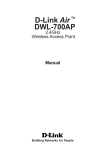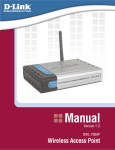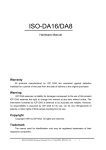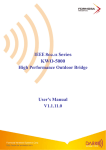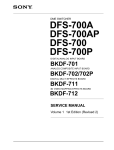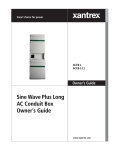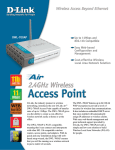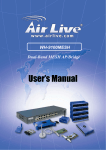Download D-Link Air DWL-120 Specifications
Transcript
TM D-Link Air DWL-700AP 2.4GHz Wireless Access Point Manual Building Networks for People Contents Package Contents ................................................................................3 Introduction............................................................................................4 Wireless Basics ....................................................................................6 Getting Started ......................................................................................8 Using the Configuration Utility ................................................................9 Networking Basics ..............................................................................21 Troubleshooting ...................................................................................34 Technical Specifications ......................................................................39 Contacting Technical Support ..............................................................41 Warranty and Registration ...................................................................42 2 Package Contents Contents of Package: ! D-Link Air DWL-700AP 2.4GHz Wireless Access Point ! Power Supply - 5V DC, 2.0A ! Manual on CD ! Quick Installation Guide ! Ethernet Cable If any of the above items are missing, please contact your reseller. Note: Using a power supply with a different voltage rating than the one included with the DWL-700AP will cause damage and void the warranty for this product. System Requirements: ! Computer with Windows, Macintosh, or Linux-based operating system with an installed Ethernet adapter ! Internet Explorer or Netscape Navigator version 6.0 or above, with JavaScript enabled 3 Introduction The versatile D-Link Air DWL-700AP Wireless Access Point is an 802.11b high-performance wireless device that can be used in one of three modes: as an access point, a repeater, or a wireless client. It is an ideal way to extend the reach and number of computers connected to your wireless network. The DWL-700AP is compatible with existing 802.11b devices such as the D-Link Air and AirPlus family of products including the DWL-650 and DWL-650+ Wireless Cardbus Adapters, the DI-614+ Wireless Router, and the DWL-120 Wireless USB Adapter. After completing the steps outlined in the Quick Installation Guide (included in your package) you will have the ability to share information and resources, such as files and printers, and enjoy the freedom that wireless networking brings. The DWL-700AP is compatible with most popular operating systems, including Macintosh, Linux and Windows, and can be integrated into a larger network. This manual is designed to help you connect the Access Point and the D-Link Wireless Adapters into a network in Infrastructure mode. Please take a look at the Getting Started section in this manual to see an example of an Infrastructure network using the DWL-700AP. The IEEE 802.11b Ethernet standard allows you to connect computers and 802.11b compatible devices at speeds up to 11Mbps, dependent upon the distance between wireless adapters, the configuration of your working environment, or the capabilities or limitations of your computer systems. 4 Features and Benefits ! 3 Operational Modes – Use the DWL-700AP as an access point, a repeater, or a wireless client. ! Fully 802.11b Compatible – Fully compatible with the IEEE 802.11b standard and interoperable with all existing 802.11b compliant devices. ! Provides a level of security with up to 128-bit WEP Encryption – Supports 64-,128-bit WEP encryption for a level of security for your data and wireless communication. ! Built-in DHCP Server – If enabled, it will automatically assign IP addresses to wireless clients on the local network. ! Web-based interface for managing and configuring – Easy-to-use interface independent of the operating system. LEDs LED stands for Light-Emitting Diode. The DWL-700AP Wireless Access Point has 3 LEDs as shown below: Power: solid green light indicates connection to a power source LAN: blinking green light indicates activity; solid green light indicates connection WLAN: blinking green light indicates wireless activity; solid green light indicates connection 5 Wireless Basics D-Link wireless products are based on industry standards to provide easy-to-use and compatible high-speed wireless connectivity within your home, business or public access wireless networks. D-Link wireless products will allow you access to the data you want, when and where you want it. You will be able to enjoy the freedom that wireless networking brings. A Wireless Local Area Network (WLAN) is a cellular computer network that transmits and receives data with radio signals instead of wires. WLANs are used increasingly in both home and office environments, and public areas such as airports, coffee shops and universities. Innovative ways to utilize WLAN technology are helping people to work and communicate more efficiently. Increased mobility and the absence of cabling and other fixed infrastructure have proven to be beneficial for many users. Wireless users can use the same applications they use on a wired network. Wireless adapter cards used on laptop and desktop systems support the same protocols as Ethernet adapter cards. People use WLAN technology for many different purposes: Mobility - Productivity increases when people have access to data in any location within the operating range of the WLAN. Management decisions based on real-time information can significantly improve worker efficiency. Low Implementation Costs – WLANs are easy to set up, manage, change and relocate. Networks that frequently change can benefit from WLANs ease of implementation. WLANs can operate in locations where installation of wiring may be impractical. Installation and Network Expansion - Installing a WLAN system can be fast and easy and can eliminate the need to pull cable through walls and ceilings. Wireless technology allows the network to go where wires cannot go - even outside the home or office. Scalability – WLANs can be configured in a variety of ways to meet the needs of specific applications and installations. Configurations are easily changed and range from Peer-to-Peer networks suitable for a small number of users to larger infrastructure networks to accommodate hundreds or thousands of users, depending on the number of wireless devices deployed. Inexpensive Solution - Wireless network devices are as competitively priced as conventional Ethernet network devices. 6 Wireless Basics (continued) Installation Considerations The number, thickness and location of walls, ceilings, or other objects that the wireless signals must pass through, may limit the range. Typical ranges vary depending on the types of materials and background RF (radio frequency) noise in your home or business. The key to maximizing wireless range is to follow these basic guidelines: 1 Keep the number of walls and ceilings between the DWL-700AP and other network devices to a minimum - each wall or ceiling can reduce your D-Link Air Wireless product’s range from 3-90 feet (1-30 meters.) Position your devices so that the number of walls or ceilings is minimized. 2 Be aware of the direct line between network devices. A wall that is 1.5 feet thick (.5 meters), at a 45-degree angle appears to be almost 3 feet (1 meter) thick. At a 2-degree angle it looks over 42 feet (14 meters) thick! Position devices so that the signal will travel straight through a wall or ceiling (instead of at an angle) for better reception. 3 4 Building Materials can impede the wireless signal - a solid metal door or aluminum studs may have a negative effect on range. Try to position wireless devices and computers with wireless adapters so that the signal passes through drywall or open doorways and not other materials. Keep your product away (at least 3-6 feet or 1-2 meters) from electrical devices or appliances that generate RF noise. 7 Getting Started Setting up a Wireless Infrastructure Network 1 2 3 4 5 6 Please remember that D-Link Air wireless devices are pre-configured to connect together, right out of the box, with their default settings. For a typical wireless setup at home (as shown above), please do the following: You will need broadband Internet access (a Cable or DSL-subscriber line into your home or office). Consult with your Cable or DSL provider for proper installation of the modem. Connect the Cable or DSL modem to your broadband router (see the Quick Installation Guide included with your router.) Connect the router to the D-Link Air DWL-700AP. (See the Quick Installation Guide included with the DWL-520.) If you are connecting a desktop computer in your network, you can install the D-Link Air DWL-520 Wireless PCI Adapter into an available PCI slot on your desktop computer. (See the Quick Installation Guide included with the DWL-520.) Install the D-Link Air DWL-650 Wireless Cardbus Adapter into a laptop computer. (See the Quick Installation Guide included with the DWL-650.) 8 Using the Configuration Utility If you wish to change the default settings or optimize the performance of the DWL-700AP, D-Link has included a configuration utility for this purpose. Whenever you want to configure your network or the DWL-700AP, you can access the Configuration Utility by opening the web-browser and typing in the IP address of the DWL-700AP. The DWL-700AP’s default IP address is shown below: ! Open the web browser ! Type in the IP address of the access point (The IP address shown in the example above is the default setting. Use this IP address when connecting to a network consisting of other D-Link devices set to their default settings. If you have changed the IP address of the DWL-700AP to conform to a network other than one with D-Link devices, then input that IP address in the web browser, instead of the default IP address shown.) ! Type admin in the User name field ! Leave the Password blank admin ! Click OK 9 Using the Configuration Utility (continued) After logging in, the screen below will appear. Click on the tabs in the screen to access different segments of the Configuration Utility. If you choose to use the web-based configuration menu, please configure the DWL-700AP from a computer with an ethernet connection to the DWL-700AP. Home > Wizard Clicking Apply will save changes made to the page. Apply Clicking Cancel will clear changes made to the page. Cancel Clicking Help will bring up helpful information regarding the page. Help Clicking Restart will restart the router..(Necessary for some changes.) Restart 10 Using the Configuration Utility (continued) Home > Wireless AP Name: You may choose to rename your access point, especially if you have more than one access point on your network. SSID: The SSID is a unique name that identifies a network. All devices on a network must share the same SSID name in order to communicate on the network. If you choose to change the SSID from the default setting, input your new SSID name in this field. The SSID can be up to 32 characters in length. Channel: Channel 6 is the default channel. Input a new number if you want to change the default setting. All devices on the network must be set to the same channel to communicate on the network. WEP Encryption: Select Enable Encryption to use WEP (Wired Equivalent Privacy) on the network. All devices on the network, and the access point, must share the same WEP selection – either Enable or Disable, and they must share the same WEP key. The WEP key is generated from ASCII or Hexadecimal entries that are either 64-, 128or 256- bit in length. When enabling encryption, select the Key Type (ASCII or Hexadecimal) and then input the appropriate digits or letters. You can create up to 4 keys. Select the key you wish to use. Hexadecimal digits consist of the numbers 0-9 and the letters A-F ASCII (American Standard Code for Information Interchange) is a code for representing English letters as numbers from 0-127 11 Using the Configuration Utility (continued) Home > LAN Dynamic IP Address: Select this option if you would like to have an IP address automatically assigned to the DWL-700AP by a DHCP server in your network. DHCP stands for Dynamic Host Configuration Protocol. It is a protocol for assigning dynamic IP addresses “automatically.” With a DHCP Server there is no need to manually assign an IP address. Static IP Address: Select this option if you are manually assigning an IP address. IP Address: 192.168.0.50 is the default IP address of the access point. Subnet Mask: 255.255.255.0 is the default subnet mask. All devices on the network must have the same subnet mask to communicate on the network. Gateway: Enter the IP address of the gateway in your network. IP Address If you need to assign static IP addresses to the devices in your network, please remember that the IP address for each computer or device must be in the same IP address range as all the devices in the network. Each device must also have the same subnet mask. For example: Assign the first computer an IP address of 192.168.0.2 and a subnet mask of 255.255.255.0, the second device an IP address of 192.168.0.3 and a subnet mask of 255.255.255.0, and so on. Devices that are assigned the same IP address may not be visible on the network. 12 Using the Configuration Utility (continued) Home > DHCP DHCP Server: Select Enabled or Disabled. Disabled is the default setting. If you want to use the access point as a DHCP server to automatically assign dynamic IP addresses on the network, you will select Enabled. Starting IP Address: If you have enabled the DHCP server function, enter the starting point of the IP address range for your network. Ending IP Address: Enter the ending IP address of your IP address range, if you have enabled the DHCP function of the access point. Lease Time: Choose the length of time during which the DHCP function of the DWL-700AP automatically regenerates the IP addresses to the devices in your network. DHCP Client Table: Lists the devices on your network that are receiving dynamic IP addresses from the access point. 13 Using the Configuration Utility (continued) Advanced > Mode Access Point: Select this option to use the DWL-700 AP as an access point in your network. Wireless Client: Select this option to use the DWL-700AP as a wireless client in your network. A wireless client is a device that connects to the network through a router or an access point. Remote AP MAC: Input the MAC Address of the remote AP to which the DWL700AP will connect when it is in wireless client mode. Site Survey: Click the Site Survey button to select a remote AP to which you wish to connect. Repeater: Select this option to use the DWL-700AP to extend the reach of a remote AP by repeating the signal. Remote AP MAC: Input the MAC Address of the remote AP that will have its range extended by the DWL-700AP. Site Survey: Click the Site Survey button to select a remote AP that you wish to repeat. 14 Using the Configuration Utility (continued) The default Performance settings are shown here. Beacon Interval: Beacons are packets sent by an access point to synchronize a wireless network. Specify a beacon interval value. Default (100) is recommended. Advanced > Performance RTS Threshold: This value should remain at its default setting of 2,437. If you encounter inconsistent data flow, only minor modifications to the value range between 256 and 2,437 are recommended. Fragmentation: This value should remain at its default setting of 2,347. If you experience a high packet error rate, you may slightly increase your fragmentation threshold within the value range of 256 to 2,346. Setting the fragmentation threshold too low may result in poor performance. DTIM Interval (Beacon Rate): (Delivery Traffic Indication Message) Enter a value between 1 and 255 (default is 3) for the Delivery Traffic Indication Message. A DTIM is a countdown informing clients of the next window for listening to broadcast and multicast messages. Basic Rates: Default is 2Mbps. We recommend that you keep the setting at default. If you lose connection at the TX rate, you will regain connection at the basic rate. A lower basic rate will make reconnection easier. TX Rates: Select the transmission rate for the network. The default rate is 11Mbps. Preamble: Long Preamble is the default setting. (High traffic networks should use the shorter preamble type.) The preamble defines the length of the CRC block (Cyclic Redundancy Check is a common technique for detecting data transmission errors) used in communication between the access point and the roaming wireless network adapters. Authentication: Open System - communicates the key across the network. Shared Key - devices must have identical WEP settings to communicate. Auto - automatically adjusts to the Authentication mode of the wireless client. SSID Broadcast: (Service Set Identifier) Enable or Disable (default) the broadcast of the SSID name across the network. SSID is a name that identifies a wireless network. All devices on a network must use the same SSID to establish communication. 15 Using the Configuration Utility (continued) Advanced > Filters Use MAC Filters to allow or deny computers by their MAC Addresses from accessing the DWL-700AP. You can either manually add a MAC Address or select the MAC Address from the list of clients that are currently connected to the broadband router (Connected PCs). The default setting is Disabled MAC Filters. MAC Filter List: This list will display the MAC Addresses that are in the selected filter. 16 Using the Configuration Utility (continued) Tools > Admin New Password: Enter the new password. Confirm Password: Re-enter the password to confirm it. Tools > System Save Settings: The current system settings can be saved as a file onto the local hard drive. Load Settings: The saved file or any other saved setting file can be loaded back on the access point. To reload a system settings file, click on Browse to browse the local hard drive and locate the system file to be used. Click Load when you have selected the file to be loaded back onto the access point. Reset: To complete the reset, click Reset. Restore: You may also restore the factory settings by clicking on Restore. Make sure to save the unit’s settings before clicking on Restore. 17 Using the Configuration Utility (continued) Tools > Firmware Click on Click here to check for the latest firmware.... Download the latest firmware to your hard drive. Then click Browse on this page to find the firmware upgrade on your hard drive. Click Apply to start the firmware upgrade. Status > Device Info This screen displays the current wireless and Ethernet settings of the DWL-700AP. 18 Using the Configuration Utility (continued) Status > Log View Log The access point keeps a running log of events and activities occurring on the AP. If the device is rebooted, the logs are automatically cleared. First Page - The first page of the log. Last Page - The last page of the log. Previous - Moves back one log page. Next - Moves forward one log page. Clear - Clears the logs completely. 19 Using the Configuration Utility (continued) Status> Stats Traffic Statistics The access point keeps traffic statistics. You are able to view the statistics of the router on both the Ethernet portion of the network and the wireless portion of the network. The traffic counter will reset if the device is rebooted. DWL-700AP Status > Wireless Connected Wireless PCs LIst This list displays the MAC Addresses of connected PC’s and the length of time that they have been connected. Help Menu Select from this menu for extra help. 20 Networking Basics Using the Network Setup Wizard in Windows XP In this section you will learn how to establish a network at home or work, using Microsoft Windows XP. Note: Please refer to websites such as http://www.homenethelp.com and http://www.microsoft.com/windows2000 for information about networking computers using Windows 2000, ME or 98SE. Go to Start>Control Panel>Network Connections Select Set up a home or small office network When this screen appears, click Next. 21 Networking Basics (continued) Please follow all the instructions in this window: Click Next. In the following window, select the best description of your computer. If your computer connects to the internet through a gateway/router, select the second option as shown. Click Next. 22 Networking Basics (continued) Enter a Computer description and a Computer name (optional.) Click Next. Enter a Workgroup name. All computers on your network should have the same Workgroup name. Click Next. 23 Networking Basics (continued) Please wait while the Network Setup Wizard applies the changes. When the changes are complete, click Next. Please wait while the Network Setup Wizard configures the computer. This may take a few minutes. 24 Networking Basics (continued) In the window below, select the option that fits your needs. In this example, Create a Network Setup Disk has been selected. You will run this disk on each of the computers on your network. Click Next. Insert a disk into the Floppy Disk Drive, in this case drive A. 25 Networking Basics (continued) Please read the information under Here’s how in the screen below. After you complete the Network Setup Wizard you will use the Network Setup Disk to run the Network Setup Wizard once on each of the computers on your network. To continue click Next. 26 Networking Basics (continued) Please read the information on this screen, then click Finish to complete the Network Setup Wizard. The new settings will take effect when you restart the computer. Click Yes to restart the computer. You have completed configuring this computer. Next, you will need to run the Network Setup Disk on all the other computers on your network. After running the Network Setup Disk on all your computers, your new wireless network will be ready to use. 27 Networking Basics (continued) Naming your Computer To name your computer in Windows XP, please follow these directions: ! Click Start (in the lower left corner of the screen). ! Right-click on My Computer. ! Select Properties and click. ! Select the Computer Name Tab in the System Properties window. ! You may enter a Computer Description if you wish; this field is optional. ! To rename the computer and join a domain, Click Change. 28 Networking Basics Naming your Computer ! In this window, enter the Computer name. ! Select Workgroup and enter the name of the Workgroup. ! All computers on your network must have the same Workgroup name. ! Click OK. Checking the IP Address in Windows XP The wireless adapter-equipped computers in your network must be in the same IP address range (see Getting Started in this manual for a definition of IP address range.) To check on the IP address of the adapter, please do the following: ! Right-click on the Local Area Connection icon in the task bar. ! Click on Status. 29 Networking Basics Checking the IP Address in Windows XP This window will appear. ! Click the Support tab. ! Click Close. Assigning a Static IP Address in Windows XP/2000 Note: Some gateways/broadband routers will automatically assign IP addresses to the computers on the network, using DHCP (Dynamic Host Configuration Protocol) technology. If you are using a DHCP-capable gateway/router you will not need to assign static IP addresses. If you are not using a DHCP capable gateway/router, or you need to assign a static IP address, please follow these instructions: ! Go to Start. ! Double-click on Control Panel. 30 Networking Basics Assigning a Static IP Address in Windows XP/2000 ! Double-click on Network Connections. ! Right-click on Local Area Connections. ! Double-click on Properties. 31 Networking Basics Assigning a Static IP Address in Windows XP/2000 ! Click on Internet Protocol (TCP/IP). ! Click Properties. ! In the window below, select Use the following IP address. Input your IP address and subnet mask. (The IP addresses on your network must be within the same range. For example, if one computer has an IP address of 192.168.0.2, the other computers should have IP addresses that are sequential, like 192.168.0.3 and 192.168.0.4. The subnet mask must be the same for all the computers on the network.) IP Address: e.g., 192.168.0.2 Subnet Mask: 255.255.255.0 Default Gateway: Enter the LAN IP address of the wireless router. (D-Link wireless routers have a LAN IP address of 192.168.0.1) ! Select Use the following DNS server address. Enter the LAN IP address of the wireless router. (D-Link wireless routers have a LAN IP address of 192.168.0.1) ! Click OK. You have completed the assignment of a static IP address. (You do not need to assign a static IP address if you have a DHCP-capable gateway/router.) 32 Networking Basics Checking the Wireless Connection by Pinging in Windows XP/2000 ! Go to Start > Run > type cmd. A window similar to this one will appear. Type ping xxx.xxx.xxx.xxx, where xxx is the IP address of the wireless router or access point. A good wireless connection will show four replies from the wireless router or access point, as shown. Checking the Wireless Connection by Pinging in Windows Me/98 ! Go to Start > Run > type command. A window similar to this will appear. Type ping xxx.xxx.xxx.xxx where xxx is the IP address of the wireless router or access point. A good wireless connection will show four replies from the wireless router or access point, as shown. 33 Troubleshooting This chapter provides solutions to problems that can occur during the installation and operation of the DWL-700AP. We cover various aspects of the network including network adapters. (The examples below are illustrated in Windows XP. If you have another operating system, these solutions will still apply although the appearance on your computer screen may differ.) Note: It is recommended that you use an Ethernet connection to configure the DWL-700AP Access Point. 1. The computer used to configure the DWL-700AP cannot access the configuration menu. Check that the Ethernet LED on the DWL-700AP is ON. If the LED is not ON, check that the cable for the Ethernet connection is securely inserted. Check that the Ethernet Adapter is working properly. Please see item 3 (Check that the drivers for the network adapters are installed properly) in this Troubleshooting section to check that the drivers are loaded properly. Check that the IP address is in the same range and subnet as the DWL-700AP. Please see Checking the IP Address in Windows XP in the Networking Basics section of this manual. Note: The IP address of the DWL-700AP is 192.168.0.50. All the computers on the network must have a unique IP address in the same range, e.g., 192.168.0.x. Any computers that have identical IP addresses will not be visible on the network. They must all have the same subnet mask, e.g., 255.255.255.0 Do a Ping test to make sure that the DWL-700AP is responding. Go to Start>Run>Type Command>Type ping 192.168.0.50. A successful ping will show four replies. 34 Troubleshooting (continued) 2. The wireless client cannot access the Internet in the Infrastructure mode. Make sure the wireless client is associated and joined with the correct access point. To check this connection: Right-click on the Local Area Connection icon in the taskbar> select View Available Wireless Networks. The Connect to Wireless Network screen will appear. Please make sure you have selected the correct available network, as shown in the illustrations below. Note: Screen shots were taken using Windows XP. Your screens may look similar. default Check that the IP address assigned to the wireless adapter is within the same IP address range as the access point and gateway. Since the DWL-700AP has an IP address of 192.168.0.50, wireless adapters must have an IP address in the same range, e.g., 192.168.0.x. Each device must have a unique IP address; no two devices may have the same IP address. The subnet mask must be the same for all the computers on the network. To check the IP address assigned to the wireless adapter, double-click on the Local Area Connection icon in the taskbar > select the Support tab and the IP address will be displayed. (Please refer to Checking the IP Address in the Networking Basics section of this manual.) If it is necessary to assign a static IP address to the wireless adapter, please refer to the appropriate section in Networking Basics. If you are entering a DNS server address you must also enter the default gateway address. (Remember that if you have a DHCP-capable router, you will not need to assign a static IP address. See Networking Basics: Assigning a Static IP Address.) 35 Troubleshooting (continued) 3. Check that the drivers for the network adapters are installed properly. You may be using different network adapters than those illustrated here, but this procedure will remain the same, regardless of the type of network adapters you are using. Go to Start. Right-click on My Computer. Click Properties. Select the Hardware Tab. Click Device Manager. 36 Troubleshooting (continued) Double-click on Network adapters. Right-click on D-Link Air DWL-650 Wireless Cardbus Adapter (or whatever network adapter you are using). Select Properties to check that the drivers are installed properly. D-Link Air DWL-650 Wireless Cardbus Adapter D-Link Air DWL-650 Wireless Cardbus Adapter D-Link Air DWL-650 Wireless Cardbus Adapter Look under Device Status to check that the device is working properly. Cardbus Click OK. 37 Troubleshooting (continued) 4. Resetting the DWL-700AP to Factory Default Settings After you have tried other methods for troubleshooting your network, you may choose to reset the DWL-700AP to the factory default settings. Remember that D-Link Air products network together, out of the box, at the factory default settings. To hard-reset the D-Link Air DWL-700AP to the factory default settings, please do the following: Locate the reset button on the back of the DWL-700AP Use a paper clip to press the reset button Hold for about 5 seconds and then release After the DWL-700AP reboots (this may take a few minutes) it will be reset to the factory default settings. 38 Technical Specifications Standards ! IEEE 802.11 ! IEEE 802.11b ! IEEE 802.3 ! IEEE 802.3u Port: ! 10/100 Mbps Fast Ethernet Data Rates: ! 1, 2, 5.5, 11Mbps (with Automatic Fallback) Encryption: ! Supports 64-,128-bit WEP Media Access Controll: ! CSMA/CA with ACK Frequency Range: ! 2.4 – 2.462GHz Operating Range: ! Indoors - up to 328 feet (100 meters)* Modulation Technology: ! DSSS - Direct Sequence Spread Spectrum ! 11-chip Barker sequence 39 Technical Specifications (continued) Modulation Techniques ! Barker (1Mbps/0db) ! Barker (2Mbps/3db) ! CCK (5.5Mbps/5.5db) ! CCK (11Mbps/8.5db) Physical Dimensions: ! ! ! Transmitter Output Power: ! 15dBm +/- 2dB External Antenna Type: ! 2.5dB gain with reverse SMA L = 5.5 inches (140mm) W = 4.5 inches (114mm) H = 1 inches (25.4mm) LEDs: ! Power (Green) ! Link (Green) ! TX/RX (Green) connector Over-Driving Levels: ! Tolerates up to +17dBm at the Antenna Device Management ! Web-Based - Internet Explorer v5 or later; Netscape Navigator v4 or later; or other Java-enabled browsers. Power Input: ! External Power Supply: DC 5V, 2.4A Weight: ! .44 lbs. (200g) Warranty: ! 1 Year Operating Temperature: ! 32ºF to 131ºF (0ºC to 55ºC) Humidity: ! 5% - 95%, non-condensing Safety & Emissions ! FCC ! UL 40








































